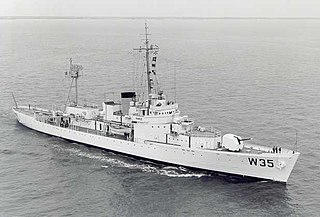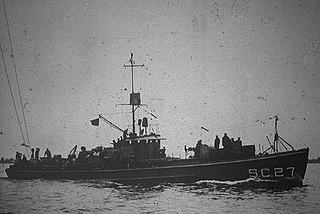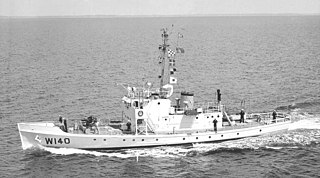USS Alexander Hamilton may refer to the following ships operated by the United States government:

USCGC Ingham (WPG/WAGC/WHEC-35) is one of only two preserved Treasury-class United States Coast Guard Cutters. Originally Samuel D. Ingham, she was the fourth cutter to be named for Treasury Secretary Samuel D. Ingham. She was the most decorated vessel in the Coast Guard fleet and was the only cutter to ever be awarded two Presidential Unit Citations.

USCGC Acushnet (WMEC-167) was a cutter of the United States Coast Guard, homeported in Ketchikan, Alaska. She was originally USS Shackle (ARS-9), a Diver-class rescue and salvage ship commissioned by the United States Navy for service in World War II. She was responsible for coming to the aid of stricken vessels and received three battle stars during World War II, before a long career with the Coast Guard. Acushnet patrolled the waters of the North Pacific and was one of the last World War II era ships on active duty in the US fleet upon her retirement in 2011.

USCGC Dallas (WHEC-716) was a United States Coast Guard high endurance cutter commissioned in 1967 at the Avondale Shipyard in New Orleans, Louisiana. She was the sixth ship or boat to bear the name of Alexander J. Dallas, the Secretary of the Treasury under President James Madison (1814–1816). She is one of twelve Hamilton-class cutters built for the Coast Guard.

The USCGC Morgenthau (WHEC-722), was the eighth of twelve 378-foot dual-powered turbine/diesel Hamilton-class high endurance cutters (WHECs) built by Avondale Shipyards in New Orleans, Louisiana. The Coast Guard commissioned the Morgenthau on March 10, 1969. After 48 years of continuous service the U.S. Coast Guard decommissioned the Morgenthau on April 18, 2017, and the ship was sold to Vietnam. On 27 May 2017 the Vietnam Coast Guard commissioned the former cutter as patrol ship CSB 8020.

USS Bancroft was a United States Navy steel gunboat in commission from 1893 to 1898 and again from 1902 to 1905. She saw service during the Spanish–American War. After her U.S. Navy career, she was in commission in the United States Revenue Cutter Service from 1907 to 1915 as the revenue cutter USRC Itasca, and in the Revenue Cutter Service's successor service, the United States Coast Guard, as the cutter USCGC Itasca from 1915 to 1922. During her Coast Guard career, she saw service during World War I.

The Charleston metropolitan area is an urban area centered around Charleston, South Carolina. The U.S. Office of Management and Budget designates the area as the Charleston-North Charleston, SC Metropolitan Statistical Area, a metropolitan statistical area used for statistical purposes only by the United States Census Bureau and other federal agencies. The OMB defines the area as comprising Berkeley, Charleston and Dorchester counties, an area with 799,636 residents in the 2020 census. Principal cities include Charleston, North Charleston, and Summerville. The area is commonly referred to as the Tri-County Area or the Lowcountry, though the latter term has historically referred to South Carolina's southern coast in general.

USCGC Point Comfort (WPB-82317) was an 82-foot (25 m) Point class cutter constructed at the Coast Guard Yard at Curtis Bay, Maryland in 1961 for use as a law enforcement and search and rescue patrol boat. Since the Coast Guard policy in 1961 was not to name cutters under 100-foot (30 m) in length, it was designated as WPB-82317 when commissioned and acquired the name Point Comfort in January 1964 when the Coast Guard started naming all cutters longer than 65-foot (20 m).
USCGC Point Banks (WPB-82327) was an 82-foot (25 m) Point-class cutter constructed at the Coast Guard Yard at Curtis Bay, Maryland in 1961 for use as a law enforcement and search and rescue patrol boat by the United States Coast Guard. Since the Coast Guard policy in 1961 was not to name cutters under 100 feet (30 m) in length it was designated as WPB-82327 when commissioned and acquired the name Point Banks in January 1964 when the Coast Guard started naming all cutters longer than 65-foot (20 m).
USCGC Point Garnet (WPB-82310) was an 82-foot (25 m) Point class cutter constructed at the Coast Guard Yard at Curtis Bay, Maryland in 1961 for use as a law enforcement and search and rescue patrol boat. Since the Coast Guard policy in 1961 was not to name cutters under 100-foot (30 m) in length, it was designated as WPB-82310 when commissioned and acquired the name Point Garnet in January 1964 when the Coast Guard started naming all cutters longer than 65-foot (20 m).

USCGC Point Mast (WPB-82316) was an 82-foot (25 m) Point class cutter constructed at the Coast Guard Yard at Curtis Bay, Maryland in 1961 for use as a law enforcement and search and rescue patrol boat. Since the Coast Guard policy in 1961 was not to name cutters under 100 feet (30 m) in length, it was designated as WPB-82316 when commissioned and acquired the name Point Mast in January 1964 when the Coast Guard started naming all cutters longer than 65 feet (20 m).

USCGC Point Young (WPB-82303) was an 82-foot (25 m) Point class cutter constructed at the Coast Guard Yard at Curtis Bay, Maryland in 1960 for use as a law enforcement and search and rescue patrol boat. Since the Coast Guard policy in 1960 was not to name cutters under 100 feet (30 m) in length, it was designated as WPB-82303 when commissioned and acquired the name Point Young in January 1964 when the Coast Guard started naming all cutters longer than 65 feet (20 m).

USCGC Point Gammon (WPB-82328) was an 82-foot (25 m) Point class cutter constructed at the Coast Guard Yard at Curtis Bay, Maryland in 1962 for use as a law enforcement and search and rescue patrol boat. Since the Coast Guard policy in 1962 was not to name cutters under 100 feet (30 m) in length, it was designated as WPB-82328 when commissioned and acquired the name Point Gammon in January 1964 when the Coast Guard started naming all cutters longer than 65 feet (20 m).

USCGC Alexander Hamilton (WPG-34) was a Treasury-class cutter. She was named after Founding Father and the first U.S. Secretary of the Treasury, Alexander Hamilton. Sunk after an attack by a German U-boat in January 1942, the Hamilton was the U.S. Coast Guard's first loss of World War II.

USS SC-27, during her service life known as USS Submarine Chaser No. 27 or USS S.C. 27, was an SC-1-class submarine chaser built for the United States Navy during World War I. She later served in the United States Coast Guard as USCGC Richards.
USCGC Point Cypress (WPB-82326) was an 82-foot (25 m) Point-class cutter constructed at the Coast Guard Yard at Curtis Bay, Maryland in 1961 for use as a law enforcement and search and rescue patrol boat. Since the Coast Guard policy in 1961 was not to name cutters under 100-foot (30 m) in length, it was designated as WPB-82326 when commissioned and acquired the name Point Cypress in January 1964 when the Coast Guard started naming all cutters longer than 65-foot (20 m).

The Active-class patrol boat was one of the most useful and long-lasting classes of United States Coast Guard cutters. Of the 35 built in the 1920s, 16 were still in service during the 1960s. The last to be decommissioned from active service was the Morris in 1970; the last in actual service was the Cuyahoga, which sank after an accidental collision in 1978.

USCGC Hamilton (WMSL-753) is the fourth Legend-class cutter, also known as the National Security Cutter (NSC), of the United States Coast Guard. She is the fifth cutter named after Founding Father Alexander Hamilton, who was the first United States Secretary of the Treasury and in that position requested the formation of the United States Coast Guard. The cutter's sponsor is Linda Kapral Papp, the wife of Coast Guard Commandant Robert J. Papp Jr.

Joint Base Charleston is a United States military facility located partly in the City of North Charleston, South Carolina and partly in the City of Goose Creek, South Carolina. The facility is under the jurisdiction of the United States Air Force 628th Air Base Wing, Air Mobility Command (AMC).



















